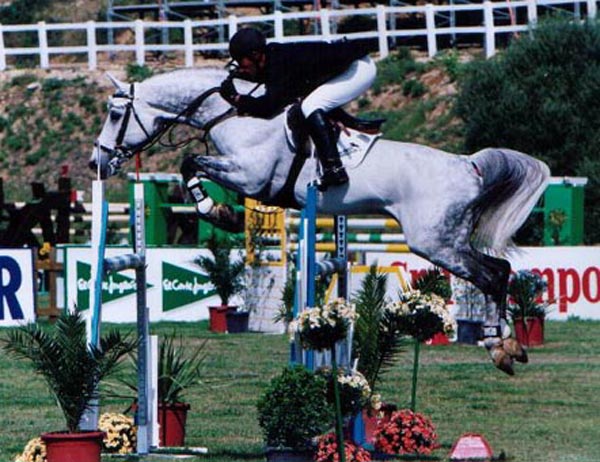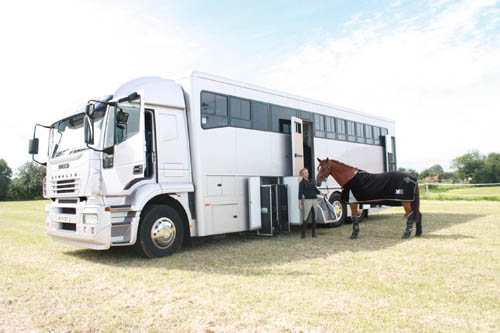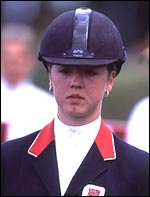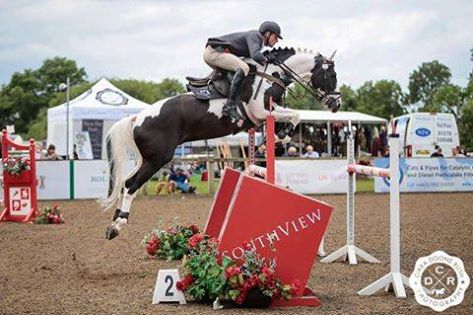Show Hunter
The show hunter is a type of show horse that is judged on its movement, manners, and way of going, particularly while jumping fences. The horses are shown in hunt seat style tack, and are often of Warmblood or Thoroughbred type, though a hunter-style pony is also seen in youth classes. In the United States, show hunters are primarily exhibited over fences, with a few additional classes offered for horses shown in-hand or on the flat. In the United Kingdom, competition over fences is called "Working Hunter," and the term "Show Hunter" describes classes held on the flat.The show hunter has long and low movement, meaning the horse should have a long, sweeping stride that covers maximum ground per minimum effort. There is not much flexion of the horse's joints as it moves; ideally the majority of the movement occurs from the horse's shoulder and hip. The action of the field hunter is efficient: the horse does not waste energy bending its legs any more than it has to. This relates back to the hunt field, where the horse had to work for several hours on end, often galloping, and inefficient movement would tire the horse more quickly.
The show hunter moves smoothly and freely, pointing its toes as it floats over the ground. It should not have excessive knee action, nor should its strides be short and choppy, both of which would make its movement less efficient. The horse should be forward, so it could jump if needed, but no faster than necessary.
The horse must always be in a balanced frame. This, too, relates back to the hunt field, where a horse had to be balanced in order to cope with the changing terrain, sometimes sudden change of direction, and surprising fences. The frame of the show hunter differs from that of dressage horses, eventers, and show jumpers, as it travels in a long and low frame, with its head moderately extended. Its frame is more "stretched out" than horses competing in dressage, eventing, or show jumping, but the horse should not be on its forehand. The riders of show hunters often ride on a slightly looser rein than seen elsewhere to facilitate this type of movement, and the horse carries its head just in front of the vertical.
Although the horse is in a long and low frame, it should still be able to collect its stride when asked. The horse must also be proficient at lengthening its canter stride while still maintaining its tempo and rhythm.
The walk of the show hunter is free and ground-covering; the trot should be balanced and flowing. The canter should be moderately collected. The horse should have a long galloping stride (12 feet is the expected length), but it should still be balanced and rhythmic.
A good show hunter must possess an excellent jumping form. The forearm should be parallel or higher with the ground, and the knees and lower legs should be even. The horse should not be lazy with its lower legs, but should tuck them under its forearm as it clears the fence, clearly bending its fetlocks and knees. The horse should not throw its body or legs to one side, but should stay perfectly straight over the fence. A good show hunter should show a great bascule, or roundness over a jump. This is often described as the horse taking the shape of a dolphin jumping out of the water, with the horse's back up, and its head reaching forward and down over the fence.
A show hunter is not only judged on movement, but also on temperament and manners. Thus, the show hunter should always be relaxed and calm, yet attentive to its rider. It should be responsive to invisible signals and look relatively easy to ride.
Show hunters are well groomed for show, clean with a shiny coat. They carry a bit more weight than an eventing horse or racehorse. The horse is bathed before the competition, with special attention paid to white markings. The hooves are polished before the horse enters the show ring.
The horse's head is trimmed, focusing on the whiskers around the muzzle, the hair of the ears, the bridle path, and lower jaw. The legs are also trimmed, removing all fetlock hair and feathering, and trimming the pasterns and coronet. In the winter, show hunters are often given a full clip, removing all the body hair, to give them a neater appearance in the show ring. The mane and forelock are braided, usually using yarn matching the color of the mane.
Tails are not pulled at the dock, so that it may be braided, and the bottom of the tail is left natural in US competition, not trimmed. The tail is braided from the top down to the end of the tail bone, with the rest of the tail left loose.
The course of fences a show hunter must jump is usually made up of 8-12 obstacles of natural type material. The fences are not brightly-colored as in show jumping, instead they are mostly brown, green, white, beige, and other natural colors. They do not exceed 4'3" in height. The course may include verticals, oxers, gates, and fences with "natural" fillers, like brush or flowers. Open water jumps and liverpools, common obstacles in show jumping arena, are not used in a show hunter course. Although combination fences may be seen, they are usually only two elements, and have easier distances between them than those found in show jumping. Banks and ditches are not found on the show hunter course, nor are any major changes in terrain, and often the horses jump on level footing in an enclosed arena.
The distance between fences is usually a set number of strides, with each stride 12 feet in length. Unlike a show jumper, the show hunter does not need to go to extreme lengths to collect or extend its stride to meet the distances correctly. The horse must put a certain amount of strides between each set of fences if they are in a line. If the horse and rider don't do this, points will be taken off the overall score.
The show hunter should maintain a good pace throughout the course of fences, but keep an even rhythm, neither speeding up nor slowing down. The horse is judged on its smoothness around the course, its movement, jumping form, and whether it reaches each "spot", or the distance of takeoff in front of a jump, correctly. A poor spot would put the horse too close or too far back from the jump, so that it would either have to stretch and make a great effort over the fence, or have to jump more "up and down" rather than over the fence. A poor spot interrupts the rhythm of a course, and increases the likelihood that a horse will rub or drop a rail.
A good ride over fences will look easy, with the horse jumping from the correct takeoff spot, easily fitting the strides in between the jumps (as opposed to having to really stretch out or collect its stride), and cleanly making the flying changes required. Refusals, knocked rails, or rubs over fences incur a severe drop (faults) in the rider's score.
Although the qualities of the show hunter are based on those of the field hunter, the modern show horse is slightly different from its more rugged counterpart in the field. The field hunter must be tougher and more durable, with great stamina, to cope with the difficulties of a long day of hunting. The field hunter must also be extremely brave, as it often has to jump solid objects, and other natural obstacles such as stone walls, ditches, banks, and hedges, and must occasionally go through water. In some countries, fences may be made of barbed wire. Unlike the show hunter, the field hunter must travel over varied terrain. In some ways, a good field hunter is more closely related to a good eventer, rather than a show hunter, as the cross-country phase of eventing includes ditches, banks, water, brush, and varied terrain.
Show hunter competition at a horse show consists of multiple classes of different types grouped into divisions, usually based on the experience or age of the rider or horse, or the height of the animal. In all classes except equitation, the horse is judged on performance and soundness, and usually also on conformation, suitability and manners.
Types of classes
Flat - Sometimes also called "hunter under saddle" or "hack" classes. These are group classes where all the competitors entered are judged in the ring at the same time. Required gaits are the walk, trot, and canter. Some classes will also occasionally ask for a counter canter or a hand gallop. At the end of the class the competitors line up in the middle of the ring and awards are given.
Hunter- Sometimes called "hunter over fences" or "working hunter" classes. Horses in hunter classes are shown one at a time over a course of jumps. The horse and rider are generally expected to enter the ring at the trot and make a large circle for about a third or one half of the ring before cantering to the course of 8-12 obstacles. After the course has been completed, they are also expected to complete another circle of similar size at the trot before leaving the arena.
Equitation - The rider is judged on riding ability and form, and though the performance of the horse is not specifically judged, it is nonetheless considered to reflect the rider's ability. Both flat and over fences classes are offered.
"Handy" classes - A hunter class that combines elements of flat and over-fences classes, often with elements reminiscent of field hunting. For example; in addition to jumping a course, the rider may be asked to open and close a gate or to dismount and lead the horse over a small fence.
Model, or in-hand classes - The horse is judged on conformation and movement suitable for that of a hunter. Horses are only led in these classes, not ridden, and the horse is presented for judging without a saddle.
Joining us on both days for the Investec Derby Festival? Why not stay at the Holiday Inn Epsom Downs Racecourse.



Sherwood Forest Wellingtons | Vitamins For Horses | Event Horses | Australian Stallions At Stud | Aberarder House - International Horse Transport | Horse Websites | Katie Price Equestrian Collection Pictures | Security Systems | Online Web Marketing | Stallions | Ellen Whitaker



